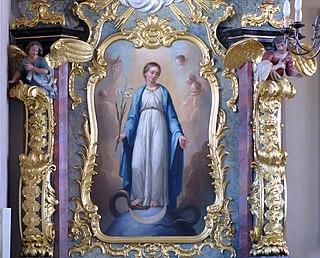
Anton Bruckner's String Quintet in F major, WAB 112 was composed in 1878/79 in Vienna.

The String Quartet in C minor WAB 111, was composed by Anton Bruckner's in 1862 during his tuition by Otto Kitzler.

The Four Orchestral Pieces are four short orchestral pieces, which Anton Bruckner composed in the fall of 1862 during his tuition with Otto Kitzler.

The Symphony in D minor, WAB 100, was composed by Anton Bruckner in 1869 between Symphony No. 1 (1866) and Symphony No. 2 (1872). In 1895 Bruckner declared that this symphony "gilt nicht" and he did not assign a number to it. The work was published and premiered in 1924.

The Rondo in C minor is a composition for string quartet by the Austrian composer Anton Bruckner. It was written in 1862 but was not performed publicly until 1984, after the composer's death. A critical edition was first published in 1985 and the piece was first recorded in 1992 by the Raphael Quartet.

Virga Jesse, WAB 52, is a motet by the Austrian composer Anton Bruckner. It sets the gradual Virga Jesse floruit for unaccompanied mixed choir.

Ave Maria, WAB 7, is a setting of the Latin prayer Ave Maria by Anton Bruckner.

Christus factus est, WAB 11, is a sacred motet by Anton Bruckner, his third setting of the Latin gradual Christus factus est, composed in 1884. Before, Bruckner composed in 1844 a first piece on the same text as gradual of the Messe für den Gründonnerstag, and in 1873 a motet for eight-part mixed choir, three trombones, and string instruments ad libitum. The motet is an expressive setting of the gradual, influenced by Wagner's music.

Christus factus est, WAB 10, is a sacred motet by Anton Bruckner, his second setting of the Latin gradual Christus factus est, written in 1873. Several decades earlier, in 1844, he had composed another piece on the same text as gradual for the Messe für den Gründonnerstag. In 1884, Bruckner composed a third, better known setting for choir a cappella.

Um Mitternacht, WAB 90, is a song composed by Anton Bruckner in 1886 on a text of Robert Prutz. About twenty years earlier Bruckner had already composed a song on the same text.

"Ständchen" ("Serenade"), WAB 84.2, is a Lied composed by Anton Bruckner in c. 1846.

Der Abendhimmel, WAB 56, is a song composed by Anton Bruckner in 1866. It is the second setting of the work. In 1862, Bruckner had already composed a first setting of the song for men's voice quartet.

Sternschnuppen, WAB 73, is a song, which Anton Bruckner composed for his own men's voice quartet in c. 1848 during his stay in the Sankt Florian.

Der Lehrerstand, WAB 77, is a song composed by Anton Bruckner in c. 1847 during his stay in Sankt Florian.
The Kitzler Study Book is an autograph workbook of Anton Bruckner which he wrote taking tuition with the conductor and cellist Otto Kitzler in Linz. Bruckner tried to complete his knowledge in musical form and instrumentation with Kitzler after the end of his studies with Simon Sechter.










